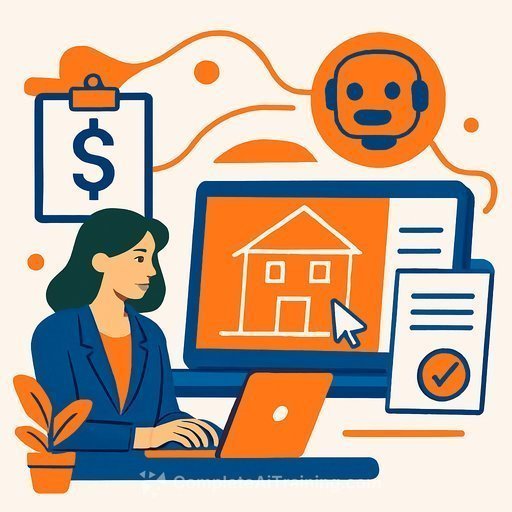September Economic Snapshot: Oracle AI Deal Fuels Bubble Fears. Is Commercial Real Estate Safe?
Oracle's stock jumped 36 percent in a day on news of an OpenAI deal, adding $244 billion in market cap. Moves like this raise familiar questions about a tech bubble. During the dot-com bust, the NASDAQ Composite fell more than 70 percent from 2000 to 2002. Historical data shows how harsh that reset was.
So, what should real estate and construction leaders do with this moment? Treat AI as both a growth driver and a risk factor-and plan against both outcomes.
Are we in an AI bubble-or just early in a long cycle?
Some caution flags are up. One senior researcher points to the "Buffett indicator"-market cap to GDP-sitting at a record high, above early-2000s levels. That ratio implies elevated market risk, even if AI momentum is real. See GDP trend data at the U.S. BEA.
Others argue this looks more like the internet buildout: messy, uneven, but ultimately transformative. Even if public tech valuations cool, AI is already being embedded across mature industries. For real estate, that means less binary risk than in 2000-and more need to position portfolios for structural change.
What a burst could mean for CRE
Data centers sit at the tip of the spear. If expected productivity gains stall, demand could soften, slowing new builds and equipment orders. That would hit near-term growth and ripple through leasing pipelines.
Office has less downside this time. Tech workforces are more remote and geographically dispersed, diluting concentrated stress. In the dot-com era, Boston and San Francisco saw vacancies jump from low single digits to the teens, and rents fell hard. Today, those markets have already reset materially, which reduces the risk of a sudden cliff.
Capital markets are the bigger wild card. A sharp reversal in AI equities could cut household net worth, cool spending, and tighten business investment. One economist warns that if foreign capital chasing AI returns pulls back, the U.S. may have to fund larger deficits domestically-pushing interest rates higher and worsening the carry on Federal debt. That would pressure cap rates, valuations, and refinancing.
Data center reality check: where the risk actually sits
Deployment has scaled dramatically since 2020, with dozens of megacampuses across the U.S. The largest concentrations are around Washington, DC; Atlanta; Richmond; Omaha; Des Moines; Chicago; Phoenix; Dallas; and Albuquerque.
There's also a technical risk worth tracking. Current large language models rely on algorithms that don't parallelize well at scale. If architectures evolve to true parallel efficiency, today's mega footprints could look oversized, stranding some capacity and affecting values. That risk is concentrated in sites built for single-config, monolithic loads.
Practical playbook for owners, developers, and lenders
- Prioritize contracted demand: Favor multi-tenant or modular designs with phased delivery tied to signed offtake, not just LOIs.
- De-risk the energy stack: Secure long-lead interconnects, redundancy, and flexible load shapes. Map curtailment risk and alternative sourcing.
- Design for change: Plan for higher-density racks, liquid cooling, and future compute shifts. Keep rooms and distribution reconfigurable.
- Exit alternatives: Underwrite reuse paths (Edge, enterprise cloud, HPC, life sciences compute) if hyperscaler demand slows.
- Term and credit discipline: Match debt tenor to lease roll, stress test for 100-200 bps higher rates, and tighten exposure limits by tenant and campus.
- Cost control: Lock EPC packages early, use escalation caps, and build contingency for equipment and labor.
- Insurance and resilience: Reassess coverage for equipment, business interruption, and cyber events.
Office and industrial: practical moves now
- Office: Target tenants with real earnings and clear AI adoption roadmaps. Use shorter free rent, stronger guarantees, and early-termination economics that protect downside.
- Industrial: If a tech slowdown hits, prioritize logistics submarkets tied to non-tech fundamentals (grocers, healthcare, building materials). Maintain diversified tenant rosters.
- Mixed-use/adaptive reuse: Keep designs flexible to flip between office, R&D, and light assembly as demand shifts.
Debt, equity, and valuation risk
- Refi readiness: Extend maturities where it's still affordable. Blend-and-extend beats a forced sale in a rate spike.
- Denominator effect: Expect some LPs to rebalance if equities fall. Line up secondary capital and preferred equity early.
- Cap rate sensitivity: Reprice assumptions for a higher-for-longer rate path. Protect DSCR with structured leases and CPI-linked bumps where possible.
Construction implications for data centers
- Site selection: Prioritize stable transmission access, shorter interconnect timelines, and favorable rate structures.
- Cooling and density: Plan for higher kW per rack and liquid solutions; keep white space modular for quick reconfiguration.
- Supply chain: Pre-order long-lead items (transformers, switchgear, chillers) and dual-source where feasible.
What to watch next
- Market-cap-to-GDP trend: If it stretches further, risk rises. Track via BEA GDP and broad equity benchmarks.
- AI equity breadth: Narrow leadership is fragile; broader participation is healthier.
- Electricity constraints: Queue delays, curtailment policies, and tariff shifts will separate viable sites from stranded ones.
- Hyperscaler commitments: Prelease depth, cancelation clauses, and take-or-pay terms will signal true demand.
Bottom line
Plan for two realities at once. If AI keeps gaining, data centers, select industrial, and well-located office benefit. If valuations reset, the bigger hit flows through rates and liquidity, not just occupancy.
Either way, disciplined underwriting, flexible design, and contracted energy and demand give portfolios the best odds.
If your team is building practical AI skills for real estate and construction workflows, explore courses by job.
Your membership also unlocks:






